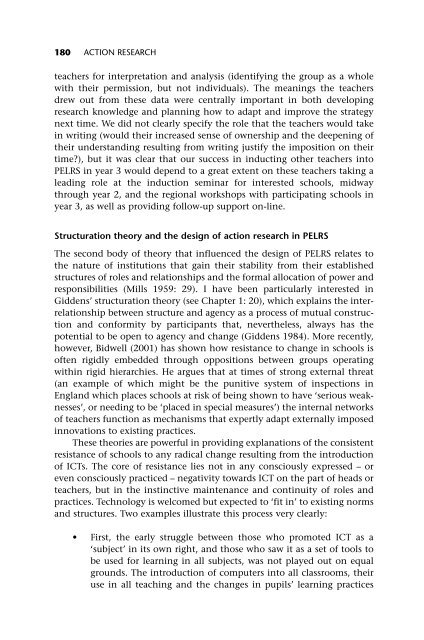Action Research A Methodology for Change and Development
Action Research A Methodology for Change and Development
Action Research A Methodology for Change and Development
Create successful ePaper yourself
Turn your PDF publications into a flip-book with our unique Google optimized e-Paper software.
180 ACTION RESEARCH<br />
teachers <strong>for</strong> interpretation <strong>and</strong> analysis (identifying the group as a whole<br />
with their permission, but not individuals). The meanings the teachers<br />
drew out from these data were centrally important in both developing<br />
research knowledge <strong>and</strong> planning how to adapt <strong>and</strong> improve the strategy<br />
next time. We did not clearly specify the role that the teachers would take<br />
in writing (would their increased sense of ownership <strong>and</strong> the deepening of<br />
their underst<strong>and</strong>ing resulting from writing justify the imposition on their<br />
time?), but it was clear that our success in inducting other teachers into<br />
PELRS in year 3 would depend to a great extent on these teachers taking a<br />
leading role at the induction seminar <strong>for</strong> interested schools, midway<br />
through year 2, <strong>and</strong> the regional workshops with participating schools in<br />
year 3, as well as providing follow-up support on-line.<br />
Structuration theory <strong>and</strong> the design of action research in PELRS<br />
The second body of theory that influenced the design of PELRS relates to<br />
the nature of institutions that gain their stability from their established<br />
structures of roles <strong>and</strong> relationships <strong>and</strong> the <strong>for</strong>mal allocation of power <strong>and</strong><br />
responsibilities (Mills 1959: 29). I have been particularly interested in<br />
Giddens’ structuration theory (see Chapter 1: 20), which explains the interrelationship<br />
between structure <strong>and</strong> agency as a process of mutual construction<br />
<strong>and</strong> con<strong>for</strong>mity by participants that, nevertheless, always has the<br />
potential to be open to agency <strong>and</strong> change (Giddens 1984). More recently,<br />
however, Bidwell (2001) has shown how resistance to change in schools is<br />
often rigidly embedded through oppositions between groups operating<br />
within rigid hierarchies. He argues that at times of strong external threat<br />
(an example of which might be the punitive system of inspections in<br />
Engl<strong>and</strong> which places schools at risk of being shown to have ‘serious weaknesses’,<br />
or needing to be ‘placed in special measures’) the internal networks<br />
of teachers function as mechanisms that expertly adapt externally imposed<br />
innovations to existing practices.<br />
These theories are powerful in providing explanations of the consistent<br />
resistance of schools to any radical change resulting from the introduction<br />
of ICTs. The core of resistance lies not in any consciously expressed – or<br />
even consciously practiced – negativity towards ICT on the part of heads or<br />
teachers, but in the instinctive maintenance <strong>and</strong> continuity of roles <strong>and</strong><br />
practices. Technology is welcomed but expected to ‘fit in’ to existing norms<br />
<strong>and</strong> structures. Two examples illustrate this process very clearly:<br />
• First, the early struggle between those who promoted ICT as a<br />
‘subject’ in its own right, <strong>and</strong> those who saw it as a set of tools to<br />
be used <strong>for</strong> learning in all subjects, was not played out on equal<br />
grounds. The introduction of computers into all classrooms, their<br />
use in all teaching <strong>and</strong> the changes in pupils’ learning practices

















